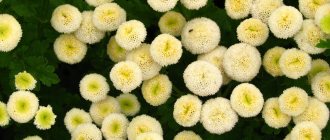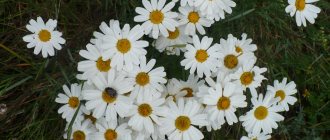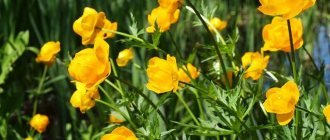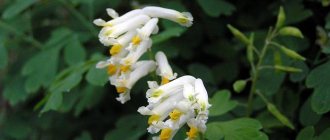Author: Elena N. https://floristics.info/ru/index.php?option=com_contact&view=contact&id=19 Category: Garden plants Published: February 10, 2018Last edits: November 04, 2020
- Rules of care
- Beautiful pyrethrum (Pyrethrum pulchrum = Tanacetum pulchrum)
- Beneficial features
Pyrethrum (lat. Pyrethrum) is a genus of herbaceous perennials of the Compositae, or Asteraceae, family, which includes about 100 species, a common feature of which is the pink or white color of the reed flowers. Pyrethrums originate from Asia, Europe and North America. The scientific name was given to the genus due to the beneficial properties of some species to lower body temperature (“pyretos” translates as “fever”, “heat”). Pyrethrums are popularly called popovniks, chamomiles or simply chamomiles.
Types of pyrethrum: girlish, pink and others
The exact number of types of pyrethrum has not been established, but there are several varieties that are suitable for home cultivation:
| View | Description | Flowers | Flowering period |
| Maiden | Perennial shrub from the southern regions of Europe. Branched, reaches 50 cm. The foliage is pale green, occasionally with tints of yellow. | Basket-shaped inflorescences, diameter about 4 cm. They can be regular or double. White and yellow. | Beginning of July – end of August. |
| Pink | Perennial growing in the Caucasus. It is grown as a biennial or annual. The stem is erect, with a height of up to 70 cm. It is one of the hybrid species. | Tubular or reed-shaped, bright yellow or pinkish in color. Buds up to 12 cm in diameter. | Mid-June – end of July. |
| Shield | Perennial, native to the eastern regions of Europe, the Caucasus. The trunk is straight, reaches 1 m. The basal foliage is about 40 cm long. | Inflorescences are corymbose, loose. Reed or tubular, yellow or white. | June July. |
| large-leaved | Perennial plant growing up to 1.5 m. | Small, formed into corymbose inflorescences. White, becoming reddish by mid-summer. | End of May – mid-July. |
And thanks to the fruitful work of breeders, several varieties of pyrethrum were also discovered:
| Varieties | Description | Flowers | Flowering period |
| Comedian | A hybrid with an erect trunk about 80 cm high. | Reed and tubular, bright red or yellow. | From July to August. |
| Robinson's Giants | The variety of pink pyrethrum is one of the most popular varieties of this plant. The trunk is straight, with a height of about 80 cm. Used for group plantings, ridges, and also for cutting. | Reed. Color: pink or carmine. | Mid-June – second half of July. |
| Golden ball | Derived from maiden pyrethrum, it belongs to the decorative varieties. Perennial, but in Russia it is grown as an annual. Grows up to 25 cm. | Terry, spherical in shape. Bright yellow color. | June July. |
| Troubadour Reeds. | A variety of pink pyrethrum. Used to decorate flower beds. | Color - from white to red. | The next year after sowing (mid-June). |
| Scarlet Star | Perennial plant up to 80 cm high. | Tubular (yellow) or reed (deep red). | Mid June – July. |
| Harmony | A variety of pink pyrethrum, with a 70 cm trunk. | Terry. Color – yellow or red. | Mid June – August. |
Popular plant varieties
There are many types and varieties of plants. We suggest focusing exclusively on the most popular:
- Pyrethrum parthenium. Height up to 0.5 meters. It is compact and highly branched. The leaves are pinnately dissected and light green in color.
Pyrethrum parthenium
The flowers are white with a yellow center; they can be either simple or double. The most popular varietal varieties are “Dal White” with white button-like flowers, as well as “Goldbal” with double yellow inflorescences. - Pyrethrum pink flower (Pyrethrum roseum). The second name is Persian chamomile. The homeland of the plant is the Caucasus. The height of the bushes is up to 0.7 meters.
Photo of pink pyrethrum The leaves
are usually dissected, the flowers are up to 5 centimeters, form racemose inflorescences, colored pink, with a yellowish center. - Red feverfew (Tanacetum coccineum). The main difference between this variety and Persian chamomile is the color of the flowers.
Pyrethrum red
It can be white or dark cherry. The leaves are double pinnately dissected. - P. corymbosum (Pyrethrum corymbosum). It is distinguished by long petiole-shaped leaf plates. The inflorescences are corymbose in shape, containing 20 baskets.
Pyrethrum corymboses
The achenes are usually gray in color, and the flowers are white. The bush blooms in June.
photo of pyrethrum Robinson Red.
The pyrethrum flower variety Robinson (Robinson Red) is very popular. It will be an ideal plant for growing in the shade. Leaves are dark green and dissected. The plant will bloom with rich red flowers, the middle will be a bright lemon shade. These bushes are up to 0.7 meters high.
Growing pyrethrum from seeds
Persian or Dalmatian chamomile (another name for pyrethrum) is effectively propagated by seed. But with such dilution, the color of the buds can turn out unpredictable.
You can grow pyrethrum using seeds in the following ways:
- planting seedlings;
- direct landing in open ground.
When using seedlings, the seeds are sown in early spring, then in May the seedlings are already placed at the final growing site. Since this planting material is quite small, professionals advise mixing it with sand and then covering it with a little soil. Pots with seedlings are covered with film to create a greenhouse effect. Shoots appear within a week.
After 3 true leaves appear, the seedlings are transplanted into separate pots. For a month, provide a temperature of +20 °C.
Seeds are planted in open ground in May-June. When seedlings emerge, the seedlings are placed so that the gap between them is about 20 cm.
Where to buy seeds?
You can purchase pyrethrum seeds in specialized flower shops, or order them by mail or through an online store.
| Variety | Where can I buy | Price |
| Golden ball | Online store Seedspost.ru (delivery throughout Russia) | 15 rubles (0.05 g) |
| Troubadour (Zedek) | Hypermarket OBI | 20 rubles (0.2 g) |
| Robinson's Giants | Online store dacha-plus.ru (delivery throughout Russia) | 21 ruble (0.2 g) |
Planting pyrethrum
It is recommended to sow seeds or seedlings in the ground in late spring or early summer, when the threat of frost has passed.
They prefer well-lit areas, although Persian chamomile feels comfortable in partial shade. With a lack of light, the trunks stretch, thereby reducing the abundance and duration of flowering.
The flower is undemanding when it comes to soil, but it is recommended to choose permeable soil, because Dalmatian chamomile does not tolerate stagnant water. In acidic soil, add ash or lime.
Summarize
Among perennials, pyrethrum is one of the most unpretentious. Even novice gardeners will like it, as it does not require any special care. Are you looking for a new flower or want to breathe new life into your garden? Then have no doubt - tanacetum will fit perfectly into landscape design and decorate any flower garden. You don't have to be an experienced gardener or designer. Even a person without experience in communicating with decorative representatives of the flora can cope with growing pyrethrum.
Pyrethrum propagation
In addition to planting seeds, the plant is propagated by dividing the bush and cuttings.
The first option for breeding pyrethrum is carried out once every 3-4 years; by this period, the flower is actively growing lateral processes. To do this, the bush is removed from the soil and excess soil is removed from it. The division is done manually. The resulting parts must be large; they are placed in holes and watered abundantly.
Cuttings are obtained from young root shoots, from late spring to August. Then they are transported to nutritious and airy soil for rooting, the container is placed in partial shade. The earth is constantly moistened, and to reduce evaporation, the shoots are covered with film. Ventilate and irrigate daily. Rooting occurs between 14 and 21 days. Then they transplant into the garden.
Outdoor care
The first and, in fact, the most important step to success when growing a crop is the right choice of place for planting it. It is advisable to provide the plant with nutritious, fertile soil with good aeration characteristics. Poor, dry or sandy soils are not suitable for growing this flower; the flowerbed will look bald and undecorative. Low-lying areas with frequent stagnant water are also not suitable for planting, since waterlogging is one of the most negative scenarios for its cultivation, especially in cold weather. When choosing a location, it is also important to pay attention to lighting. This cultivar does not like open places; it must receive dosed sunshine and be in the shade most of the day.
Watering mode
In this matter it is important to find the right balance. The crop reacts equally negatively to both too dry content and waterlogged soil. The root system easily rots in wetlands. The crop tolerates drought and insufficient watering more easily, however, the flowers gradually become smaller, lose their bright color, and in prolonged cases, their buds. Particularly decorative breeding varieties and hybrids may die.
Many varieties of pyrethrum can bloom a second time closer to autumn, but only under conditions of high-quality care and timely watering.
Top dressing
During the period of growing seedlings and active budding, the plant does not require additional nutrition. Flowers obtain everything they need from the soil, provided it is sufficiently nutritious. On poor soils, it is recommended to apply phosphorus fertilizer at the beginning of flowering and nitrogen fertilizing after its completion.
Autumn feeding is considered mandatory for any substrate. It is added after flowering has completed and dry flower baskets have been removed. A complex mineral fertilizer is used, intended for flowering open ground crops. Excessive feeding is harmful for this crop, as it can cause rapid growth of green mass, which will inhibit flowering.
In regions with early cold winters, it is not recommended to stimulate pyrethrum to bloom again, as it may go into the winter unprepared and die.
Trimming
Early flowering comes to an end already in mid-summer, after which the bushes begin to be burdened with an abundance of wilted buds and withered foliage, which by this time also begins to dry out. This not only does not look aesthetically pleasing, but also does not benefit the plant itself, draws out the remaining juices from it and interferes with its preparation for winter. The planting must be carefully trimmed with pruning shears at a height of about 10 cm from the ground. If there is a desire to get re-blooming, at this stage the roots are fed with a liquid nutrient mineral complex.
Timely removal of fading buds can significantly prolong flowering.
Diseases and pests of pyrethrum
As pyrethrum grows, it is susceptible to insect attack and disease:
| Symptoms (effect on foliage) | Disease/pest | Corrective measures |
| Fluffy gray coating, trunk deformation. | Fusarium. | Affected flowers are removed from the ground and burned. The area where the plant was grown is treated with any fungicide. |
| Holes. | Slugs. | Collected by hand. Correct the irrigation regime, preventing water stagnation. |
| Wilting, white spotting. | Thrips. | The plant is removed from the ground and thrown away, the soil is sprayed with a systemic fungicide. |
| Yellowing. | Aphid. | In case of severe damage, pyrethrum is removed from the soil and removed from the site. If there are a small number of pests, the bush is treated with Insecticides (Aktellik, Aktara or Biotlin). The actions are repeated 2-3 times. |
Mr. Summer Resident advises: pyrethrum in landscape design
Used in carpet-type flowerbeds for edging. In this situation, the bushes are trimmed to the required height and prevent the formation of buds.
They are also used to decorate borders. Bright colors improve the appearance of borders and mixborders.
This shrub is considered the most optimal for decorating a garden in a country style. This is explained by the fact that the flower looks great and takes root nearby with ornamental plants.
The flower is used to decorate loggias and terraces. It is also suitable for arranging bouquets.
Photo of Persian chamomile
A photo of pyrethrum cannot help but attract attention, thanks to the rich color of the petals. The photograph of an adult plant shows that over time and with proper care, the bush becomes wider in diameter. Lace leaves appear along the entire length of the thin stems.
If you look closely at the bud itself, it becomes clear that the large flower is a dense inflorescence consisting of small, true yellow flowers surrounded by large pink petals. They form a fairly large receptacle. The buds themselves are tubular in shape. They all accommodate anthers. With a high magnification of the photo, you can even see the small yellow petals. These buds are pollinated as they ripen, and seeds are formed in them.
The scarlet and pink tongues that surround the receptacle have a completely different task. And pollination with the ripening of seed is not included here. The outer petals are designed to attract insects to the receptacle.
Useful properties of pyrethrum
In the old days, Dalmatian chamomile was used to lower fever, eliminate inflammation and headaches. It has been proven that this flower has properties similar to aspirin.
In the 1980s, scientists noted feverfew as an effective substance in the fight against migraines. It was said that the powder of this plant relieves severe and frequent headaches much faster than expensive medications. This was explained by the fact that the flower contains parthenolide, which helps block the synthesis of serotonin. And, as you know, excessive content of this component in brain cells and blood vessels is recognized as the cause of migraine formation.
In addition, Dalmatian chamomile blocks the production of histamine, prevents the formation of blood clots in blood vessels, and has antimicrobial and anti-allergenic properties. The leaves are used to create applications against arthritis and rheumatism, and are used to treat asthma and relieve pain during the menstrual cycle.
In combination with medications, feverfew eliminates allergic manifestations of dermatitis and psoriasis.
This plant has an unusual appearance and medicinal properties, which attracts a large number of gardeners. Decoctions from this flower are often given to young children with allergies accompanied by severe rashes.











